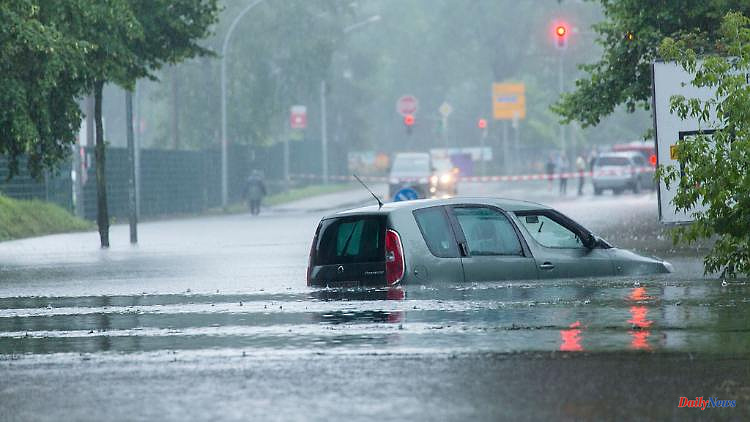Storm and heavy rain ahead. If water then gets into the car, it can quickly lead to a total loss. You should be all the more careful if you drive into flood-prone areas - but it can be much more dangerous.
Cars are well protected against rain, storms and hail - as long as the precipitation mainly comes from above. This is ensured by a well sealed body. When it rains heavily, however, it can quickly happen that roads or parking lots near water bodies flood and the water rises dangerously high.
"Splashing water isn't the problem, because cars can handle it well. However, if water gets into the vehicle, the battery and the electronics can be damaged," says Katja Legner from ADAC. "This applies equally to combustion engines and electric vehicles."
But if you drive through water too fast, you risk the car floating and losing traction. According to the ADAC, normal cars and most SUVs are only designed for a maximum water depth of 20 to 25 centimeters at low speeds. "If the water is higher, it cannot be ruled out that the vehicle will break down," says Katja Legner.
It can be far more dramatic for the occupants than the damage to the vehicle when a car threatens to sink. "The greatest danger comes from the water pressure, which then prevents the doors from opening," says Frank Hachemer from the German Fire Brigade Association (DFV).
It is therefore important to open a window or the sunroof - if possible before the vehicle sinks, but at the latest when sinking in. "The water has to get into the vehicle. That can be vital, because this is the only way to equalize the pressure," says Hachemer.
However, since modern cars are only equipped with electric windows, the only thing that helps in an emergency is a rescue hammer to smash a side window. "Side windows are usually easier to smash than the front window, which is made of laminated glass," says Hachemer. However, very few drivers have such a rescue hammer (costs: around 10 euros), which usually also includes a seat belt cutter.
Frank Hachemer advises a defensive driving style so that motorists do not even put themselves in the danger of potential flood risks: "If you cannot estimate and see how deep the water is on a flooded road, you should rather take a different route." Otherwise, the danger is great that the car will remain at the lowest point - with possibly dramatic consequences.
Underpasses that have filled with water are particularly dangerous - because the depth of the water here is particularly difficult to estimate: "In the worst case, drowning is also possible here," says Hachemer.
If a parked vehicle is trapped by flood water, the consequential damage is initially difficult to estimate. "If the water has penetrated over the door sill and even into the interior, damage is very likely," says Katja Legner. "In these cases, it is advisable to have all components that have come into contact with water checked in the workshop." This includes, for example, the belt tensioner.
"The most important advice in such cases: Don't risk consequential damage." So don't even start the car and, if necessary, push it to the next dry place or have it towed. Then disconnect the battery and have the car taken to the workshop.
Depending on how high the water level was and how long the car was in it, serious damage is to be feared. If a vehicle is completely lost, you have to assume that it is a total loss, says Legner.
If you are affected by flood damage, you should always contact your car insurance company immediately. Partial casco covers damage caused when the vehicle was parked in a flood area and there was no way to remove the car in time, explains Katja Legner.
However, if you are driving on a flooded road and water gets into the engine as a result, you will only be able to handle the damage with fully comprehensive insurance. According to Legner, driving behavior is the cause of damage here.
Areas at risk of flooding are usually marked with appropriate warning signs, says Frank Hachemer. In the vicinity of shores there are often those that indicate a harbor edge or shore areas with a pictogram of a falling car and waves. If you park here, you should pay attention to the weather forecast.
In general, the risk of flooding as a result of heavy rain has increased in recent years. It is particularly high when it is very warm over a longer period of time. "Then the atmosphere can absorb more moisture and the showers are particularly strong during a hot thunderstorm, for example," says Sebastian Wache from the Wetterwelt weather service in Kiel.
Heavy rain is when more than 15 liters per square meter fall per hour. Rainfall of 40 liters or more per hour is really extreme. The great danger comes from the amount of precipitation in such a short time. Since it was often dry for a long time beforehand, the soil is then not able to absorb the water. "So the water doesn't seep away and flooding occurs quickly," says the meteorologist. The many sealed areas in cities and streets also made it difficult for the water to run off.
Any region can be affected, although there are areas that are more likely to be affected. "The east of Germany is actually a rather drier region with fewer heavy rainfall events. In summer, southern Germany is also subject to the influx of air masses from the Mediterranean. The air is wetter and warmer there, which can lead to heavy showers locally," says Wache.
Drivers could get caught in "white walls" almost instantly. They form when the air in the shower clouds cools down very quickly. "Even the strongest setting of the windscreen wipers can't cope with this and if the speed is not adjusted, there is a very quick risk of aquaplaning," says Wache.
According to the ADAC, the following applies: slow down and turn on the lights. Pay attention to ruts and drive offset to them. If the car floats: "Don't steer, don't brake, don't accelerate, no hectic driving manoeuvres," the Autoclub advises online: "Let the vehicle roll with the clutch disengaged, hold the steering wheel straight until the tires are in contact with the road again."
6












